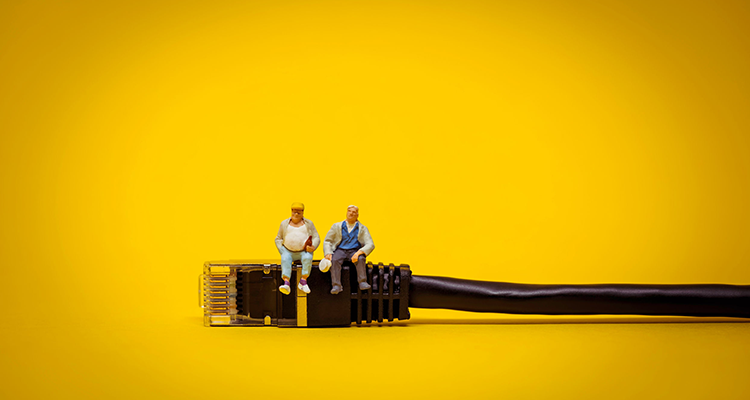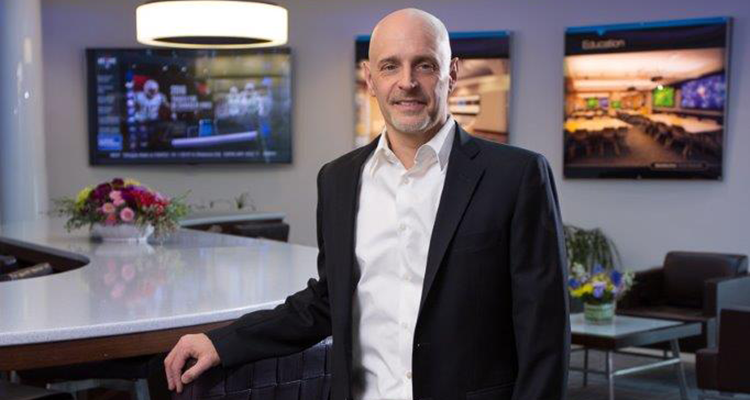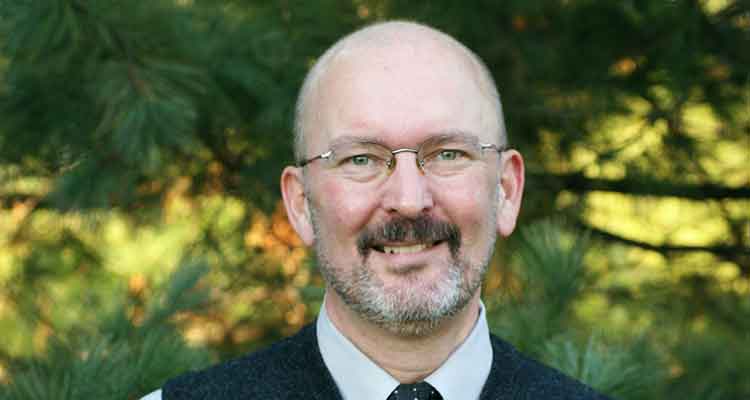Inside The EcoChamber: Interview with Bruce Toman of Perkins+Will
 September’s Inside the EcoChamber interview is with Bruce Toman, AIA, a principal with Perkins+Will and member of InfoComm’s Smart Building Imperative Task Force.
September’s Inside the EcoChamber interview is with Bruce Toman, AIA, a principal with Perkins+Will and member of InfoComm’s Smart Building Imperative Task Force.
Scott Walker: As we in the AV industry play catch-up to the overall A/E/C industry with regard to sustainability, there are lessons we can learn about what it felt like for architects 10 to 15 years ago when LEED was launching and gaining traction. Were you at Perkins+Will in the early days of LEED? Also, there is an urban myth that Perkins+Will wasn’t necessarily early to the sustainability game, but some young hires right out of school began to influence management by saying, hey, we’re missing the boat here. So then Perkins+Will went whole hog into LEED and sustainability. Is there truth to that?
Bruce Toman: I was not with Perkins+Will when LEED was new in the industry. I had some friends who knew about LEED and suggested I get accredited by taking the test, so I got involved and understood the importance of it early on. I took the exam and became a LEED AP, and then I came to Perkins+Will, a firm that had made a very conscious business decision about LEED. There were people of a certain generation — those of us above 40 to 45 years in age — who had the most experience in our profession, who understood that sustainable buildings were the future of architecture, who taught our children that protecting the environment was a great thing, but who were sidelined by a “do as I say, not as I do” approach. Then suddenly we were faced with a whole generation of young architects who really understood sustainability well and who pushed us and drove us to be sustainable. They were trained in sustainability, whereas we never were; we were trained in aesthetics and efficiency and functional use of buildings, but never really thought about sustainability. So we had a group from the bottom pushing in a new direction instead of pushing from the top.
In addition to that younger generation, there were a couple of more experienced guys who got it early and who were instrumental in influencing the corporate leaders of Perkins+Will as they made long-term plans for the firm. During that process we did two things: First, we committed to LEED; second, we began looking for partners who were already producing sustainable buildings, one of which was Peter Busby, who was practicing in Canada and had instincts about taking care of the environment in a way that was much stronger than anything we had done.
SW: I know there was a time in the mid-2000s when each architect was out-greening his/her competitors. How did your commitment to LEED change the way Perkins+Will won commissions?
BT: We determined that one of the best ways to solidify the new commitment for Perkins+Will was for everyone to become LEED accredited as the organizing element in getting the firm further down the road to producing sustainable buildings. We provided incentives to our staff for becoming LEED accredited and we supported that initiative by giving them as much training as they needed to pass the exam. That was a very successful way of raising our consciousness internally about the importance of a sustainable approach to projects. The secondary effect was that it raised our profile as a firm, and we began to be recognized as the firm with most LEED accredited professionals. We also marketed the initiative by telling clients that we were committed to LEED, and as much as possible we would like to produce buildings that are certified at some level. Even when clients weren’t initially interested, we still stuck to the LEED principles whether the building was going for certification or not, and we obligated ourselves to achieving that without costing the client extra money. Committing to LEED had real value in gaining us recognition as a firm very committed to sustainable buildings.
SW: The turning point for me actually came from an architect, William McDonough. I saw him speak and read his book “Cradle to Cradle,” and then it clicked: This is one big interdependent system, upon which buildings have a huge impact.
BT: He has certainly been a real leader in our profession. He embodies everything he believes and has been hugely instrumental in raising awareness and in influencing people in the profession.
SW: How was your experience as an architect before LEED different than it is now in the post-LEED world? It seems like you can’t do an unsustainable project anymore, even if it’s not going for LEED. Is that accurate?
BT: I have practiced in states with very strong energy codes, so there was some consciousness of sustainable values even back then, but LEED opened that up to all architects and now there are definitely aspects of LEED we try to incorporate no matter what. But ultimately we have seen that by and large, owners ARE interested in LEED and/or sustainable practices. Professionals in general, of all generations, are demanding buildings with greater sustainable characteristics and market forces follow that trend, so owners are paying attention and buying into the process, almost regardless of personal convictions.
SW: As we launch STEP, we understand there are certainly aspects of LEED to model and mimic and appreciate even while we attempt to address deficiencies in the system. One of the challenges is that we are launching this in a tough economy and are facing battles LEED may not have had coming up in a strong economy. What are lessons learned that we can use for STEP, and what should we do differently especially considering current economic conditions?
BT: Part of what was advantageous for LEED was that it had a broad range of topics, which was good and bad. There are some parts of LEED that are what I would call bad “earmarks” and were included because certain forces had a greater influence than others during LEED’s founding and early growth. The advantage of that was that it had such a wide range of topics that it covered that you could find things across the spectrum to comply with and at the very least achieve minimum certification. It made it easy to apply the principles. The flip side was that certification — the “prize” and marketing benefit — became more important than the results we were trying to achieve. And because certification could be achieved by meeting so few requirements in such a broad range of areas, it didn’t really drive us to build exceptionally better buildings. We should be paying the closest attention to energy conservation and to achieving net zero buildings, but LEED is not as focused on innovation as it is adhering to prescriptive methods for getting a plaque. STEP must be able to provide avenues for innovation without additional cost to clients.
SW: One of the challenges we’ve had in promoting STEP is answering for the client whether STEP is a business opportunity or a cost burden to providers. During LEED’s early days, were architects taking it in the chin or was it recognized as a business accelerator?
BT: My experience, not just with LEED but with many trends in architecture, is that the profession is becoming much more complex while the fee structure has not changed, so architects are tasked with channeling their creative energy into sales, winning a project at the lowest possible fee, and then figuring out how to make it work, which of course does not always lead to the highest quality product. There are areas, such as commissioning and documentation, where the owner is willing to pay architects additional fees, but it is difficult to make a case for a higher fee during the design process. In the early days when we discussed this with clients, the common answer was, “Sure, I’ll do LEED as long as it doesn’t cost me any money.” Thus, LEED has had more value for us in being able to say this is what we’re all about, which attracts clients who are more inclined to understand and accept the costs involved in designing a sustainable building.
SW: LEED isn’t the only game in town anymore. Architecture 2030 is an architect-led initiative that has been around for a while, and then we have ASHRAE 189.1 and IgCC. Which standards currently dominate conversation among architects committed to sustainable buildings?
BT: We as a firm have consciously said that while LEED has been great to us, it’s not the be all, end all for sustainable building design. What we really want to do is create net zero buildings; we want to meet the 2030 Challenge and be designing and constructing net zero buildings by 2030, which is a huge challenge. In reality, when we look at what we’re doing today, we’re not hitting great numbers yet. We still have a long way to go on energy and water conservation. If we focus on energy and are less focused on renewable materials, how does that change what we do with buildings? The buildings that are really interesting are the ones making major advances in energy conservation. They are drastically different from anything we’ve done in the past and a lot of what we’re doing currently. We see 2030 as the future for us.
SW: All of that is kind of the backdrop to STEP, which you have had some exposure to in your involvement with InfoComm’s Smart Buildings Imperative. One of our head-scratchers is whether there is room for another rating system or are people getting weary of green ratings; are they moving instead toward making sustainable design the gold standard outside of ratings? We are not going to get to net zero if we aren’t serious about energy conservation, so are people going to recognize that LEED accomplished important goals, but now there’s a new thing that will get us over the next innovation hump, or are they going to throw everything out with the bath water and say, we’re tired of rating systems?
BT: One of the things we have come to understand is that LEED is a really effective tool for educating us about sustainable buildings, but is less and less effective in providing guiding principles for making the kinds of leaps we will need to make to achieve reductions in energy use. I believe ratings or not, the market force change will happen when we are not dependent on off-shore energy sources. One of our greatest challenges is the fact that basic cost of energy is still pretty low in this country, so the driving force is the cost of energy; it is very difficult to make a case for energy conservation when buying energy is cheaper than funding innovation that may not necessarily lead to lower building costs. The big positive that we see is a real change in the market in terms of who is using our buildings; again, as the younger workforce comes into the market and demand smarter environments — from repurposing old warehouse spaces into trendy offices, to providing clean power and a robust technology infrastructure, to things as simple as having an abundance of bicycle racks — building owners want to accommodate those demands and attract top talent to cities and companies focused on growth. I see  STEP as a huge advantage for us in bringing out the greatest aspects of what businesses in this era require. In some sectors, I expect that STEP will be much more important than LEED in achieving the technological standards today’s businesses are looking for and demanding.
STEP as a huge advantage for us in bringing out the greatest aspects of what businesses in this era require. In some sectors, I expect that STEP will be much more important than LEED in achieving the technological standards today’s businesses are looking for and demanding.
Scott Walker, CTS-D, LEED® AP, is president and CEO of Waveguide Consulting, a leading AV, IT and acoustical consulting firm. He is also a past president of InfoComm International. Scott is recognized as being one of the primary forces behind the founding of the Sustainable Technology Environments Program (STEP) rating system and currently is a member of the STEP Foundation board, which is responsible for managing the STEP program. Scott can be reached at swalker@waveguide.com





